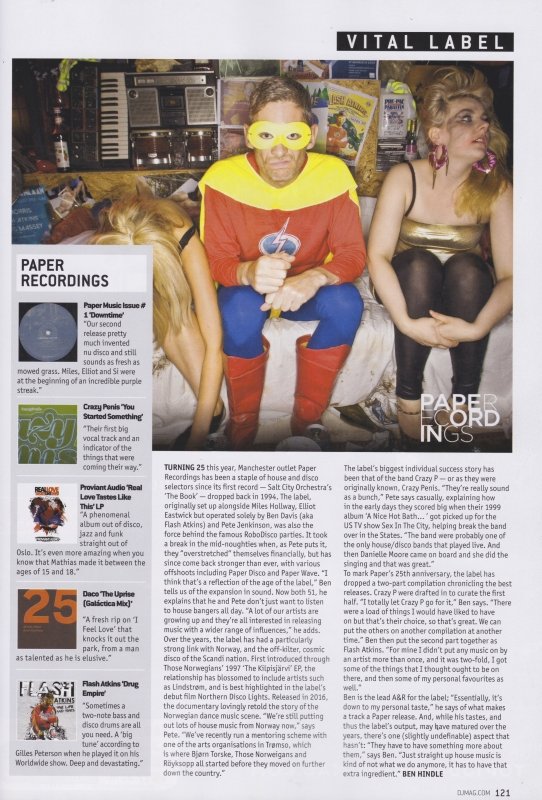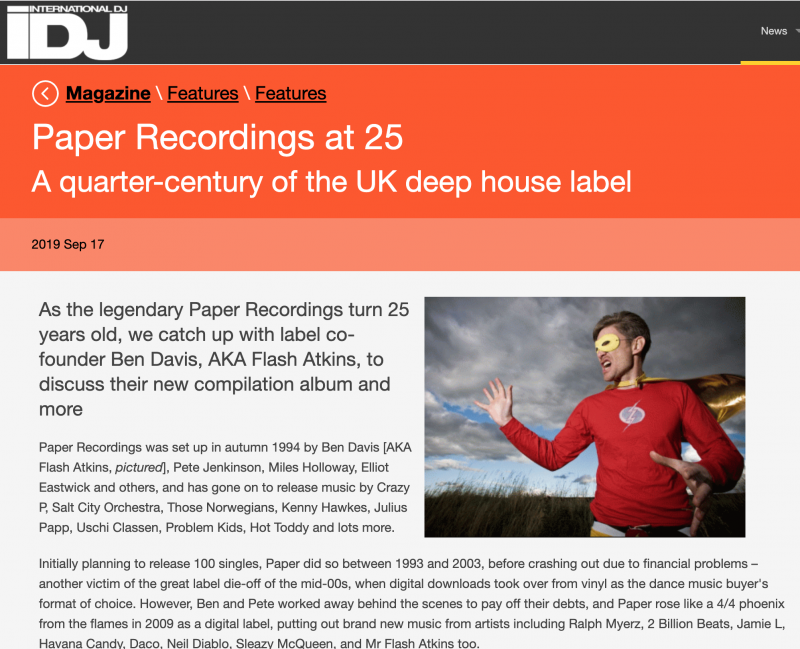Travelling around Norway in the Spring is a fantastic experience. During my trip in 2013, we hooked up with the key movers and shakers involved in forming the country’s house and disco scenes. I was lucky enough to touch down in Oslo, Bergen and Tromsø, and many weird and beautiful places in the surrounding areas. I travelled with Ben Davis, who was directing the film we were working on, formed from interviews with the key people from the dance scene plus Paper Recording’s label artists such as Those Norwegians. We were also curious about the country, geography, and people and how they influenced each other’s creative passions. This film had a working title of ‘Northern Disco Lights – The Rise and Rise of Norwegian House Music’. During our visit, we spoke to as many of the DJs, producers, promoters and radio stations as we could and decided to publish these best bits that sum up the trip, the film and our findings.
Bjørn Torske’s recording career began with the “T.O.S. EP” compilation released on Belgium’s SSR Records where he appeared as Alegria, and with Ole Johan Mjøs as Radikal Buzz. Torske and Mjøs then formed Ismistik and released 3 EPs on Dutch label Djax, as well as collaborating with Rune Lindbæk & Ole Johan Mjøs in Open Skies [Reinforced Records] and Volcano [Olympic Records] in 1992. During this period Torske moved to Bergen, and currently DJs internationally and releases his music on label Smalltown Supersound (STSS).
Hi Bjørn, Please tell us what it was like growing up in Tromsø?
It’s not a big place and was kind of boring because there wasn’t much music culture in Tromsø, so we started listening to music that came from other places. A lot of the older people that we knew, travelled to London and other European cities picking up on the music and scenes that were happening there. I was 13 and at school when I started listening to hip hop music and early electro. We just copied and shared cassette tapes between us; we didn’t buy vinyl records back then. Plus, there weren’t that many records in those genres available, so we started with double cassette decks, making our own remixes using the pause button. We were listening to the local radio stations which were doing the same thing with the music and mixing; certain shows were picking up the music and in some cases buying it on import; especially Vidar Hanssen who runs Beatservice Records and his radio show was by the same name. In retrospect, I think of him as having real importance to the scene because he was playing all sorts of stuff like body pop, Prince, The Cure; an alternative selection of genres and sound. We were mostly into the electronic, harder stuff but then house music came along, and he started playing lots of that as well. We didn’t like it immediately (there was far too much cheerful piano), our tastes were darker and more intense, we liked Front 242 and bands like that. Gradually though, things started changing and eventually a couple of friends and I started doing our own show at a station called Brygga Radio.
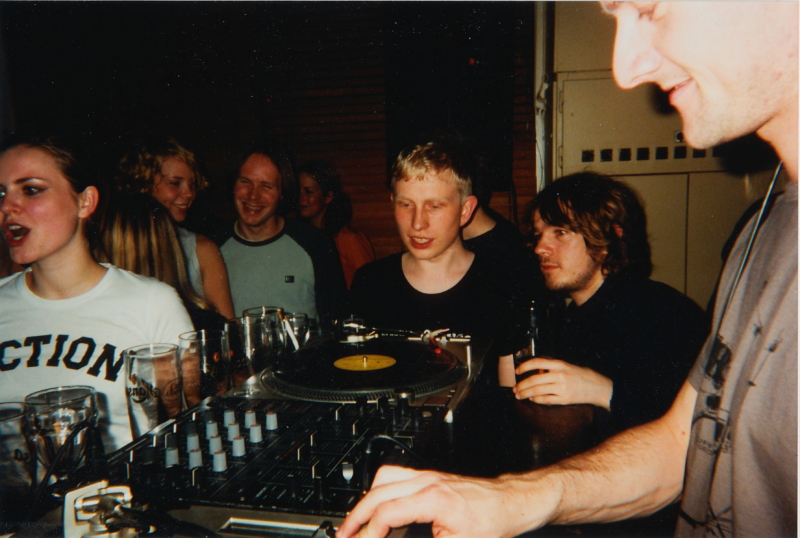
Bjørn Torske & Strangefruit in Bergen circa 1993
We got access to tape recorders, four-track cassette recorders so we could develop our pause button remixing ideas. We started to make remixes and megamixes for our own shows splicing tape and other techniques. Before we knew it, we had our own sound, started playing around and programming and eventually began making our own tracks. I had a friend who was really into scratching who came on the shows and performed live. When I graduated from school, I was unsure of what to do because my parents wanted me to go to university and become an engineer. But that wasn’t tempting to me, so we got some equipment together and began to make a record to see if a label would be interested in releasing it. Geir Jenssen [Biosphere] listened to some of the music I had made at home on my four-track cassette recorder and said, “Yeah, if you could do this properly, produce and mix it I would like to send it to Crammed Discs in Belgium”. Excitedly we put together a proper production and it was sent off, accepted and released. That was in 1991 which was the start of it all and we were all based in the tiny, boring, quiet and northern Norwegian town of Tromsø!
Who were your contemporaries during this time? For my radio show it was Ole Johan Mjøs, who was also crucial in an early project called ‘Ismistik’ which was released on Djax-Up-Beats in Holland, and Open Skies, together with Rune Lindbæk on ‘Reinforced Records’ from England, and later on there was a more pop project called ‘Volcano’ on which I was involved in two single releases before I moved to Bergen.
Why did you decide to move to Bergen?
I moved to Bergen when I joined the Civil Service, which is our alternative to the Military service, I think you call it the National Service in the UK? I managed to buy an Akai 1000 sampler, which was really expensive at the time and together with my Atari and keyboard, I suddenly had a studio set up where I could produce music. I decided that this was my destiny, I was already on the DJ circuit and then it happened ‘Bang’! The day I moved to Bergen, the friend that met me at the airport said, “We’re starting up a club. Do you want to DJ there?”, I think you know the answer! The club was called Phoenix and it was in a basement on the other side of town and at that time they had odd licensing laws that meant you could serve alcohol until 1 o’clock, but you could stay open until 5 am. It was an after-hours club. It’s never been anything of the sort, later, because the rules were stricter, but that was really happening at the time. Kai Stoltz (Kahuun) DJed there as well. There was also a guy called Anders Kofsky and he’s still kind of part of the scene but doesn’t DJ play as much. I met Tore [Erot] at the Phoenix, together with Mikal Telle. Erot was still very young then, about 16 or 17 so he wasn’t really allowed into the club, but we managed to get him in any way. So, we started hanging there and some years later (1995) we started DJing together at Café Opera. He started producing his earliest tracks on cassettes and he told me about his working method and processes using the most basic software. I remember him astonished by the sequencer and other hardware I was using such as Q-Base software. I gave Erot’s demo tape to Per Martinsen of Mental Overdrive and he liked it. Per had his own label called Love OD but I had an idea for my own label, which I had already been discussing with Per. He set up a P&D (Press & Distribution) deal with a company in England and the label ‘Footnotes’ was born.
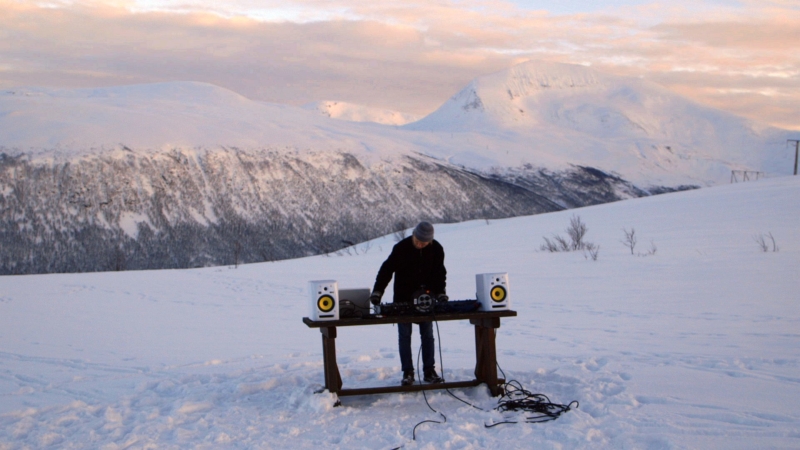
Bjørn Torske DJing Storsteinen (421 m above sea level), 2013
Would you say that Erot and yourself influenced each other musically? We definitely did and I must say that Paul Strangefruit’s role in promoting the disco sounds of the 70s and 80s were an influence on us all. Prior to this, we had been having a laugh about ’70s disco being too ‘kitsch’, but when we started digging in the disco underground and finding tunes that were more funk and groove-based we started taking notice. We realised that the house music that we loved was based on these disco earlier tracks, and that was how the house genre really began. The studio versions of older instrumental disco tracks and Paul Strangefruit was at the forefront of this craze as he had been buying this music since he was 13, in his hometown of Harmar.
How did your relationship with Svek come about? The relationship with Svek Records came through Erot’s music being signed by Svek after they had heard his release on Footnotes. He was initially asked to do a remix that turned out to be very popular so they asked him to do an original track for them. I had made a track which I didn’t know what to do with, so we ended up on either side of a 10″ vinyl in 1999: Erot’s ‘Battlestar XB-7’ and my ‘Jeg Vil Være Søppelmann’ track. We were aware that it was working on the dancefloor because we had been playing it prior to release from DAT and CDR. It has a very ‘dirty’ sound that was reworked during mastering, and when it was released on Svek I heard that two copies had been mixed up together at Miami Music Conference by Danny Tenaglia which was very gratifying.
Can you tell us how Telle Records was set up? Mikal Telle started a record shop in 1995, called ‘Primitive’ stocking mainly of hardcore punk, electronic and hip hop music. When the Bergen scene started evolving around new artists such as Erot, his Footnote 12″ was released and other artists like Ralph Myerz started appearing that were making music were making new, exciting music. Mikal was the ‘professional fanboy’ and he wanted to see others be successful, but saw that musicians, producers and DJs weren’t very good at organising; and he could do that! He put on the first Den Elleville Festen Festival in 1997 that generated funds for him to release his first 7” single on Telle Records. We were all astonished at how quickly the label became so widely recognised. I think Erot’s presence had a lot to do with it because he already had a strong fan base and his releases always did well, but the combination of Mikal and Erot is what made Telle’s launch so successful.
Do you know what sparked Erot’s interest in dance music? I can trace it back to when I started hanging out with him at the Phoenix. He went there with an older friend of his, Svein Arvie whom he produced music in their bedroom studio setups. The first time I heard anything they made together was 1994, I think. It was a rave style type of track with a lot of silly samples; and really funny. I don’t know if any of those tapes still exist, but what do I know is that Todd Terje’s big sister was a friend of Erot, so Todd will have heard the music on those tapes when he was 10 to 12 years old. Those tapes were my first experience of Erot’s music-making as well.
What is your relationship with Todd Terje? My relationship began through Prins Thomas, who is an old friend as he lived in Bergen around 2000 before he moved to Oslo. Thomas started talking about someone on the scene that turned up at all of his club nights and asking lots of questions about the music he was playing. Whether it was a new vinyl or the repress; we called him ‘Disco Terje’. He started producing edits and hanging out with Thomas, who did a remix of Terje’s first release ‘Akwaaba’, ‘Bodies / Boozefinger’ on Bear Funk in 2004. I started to get to know him when he started making music and DJing. He’s very particular about how he’s going to produce his music, it’s cheeky a bit like Erot’s approach. He has that magic ingredient that I can’t put my finger on, it just makes you dance.
Norwegian music consists of many musical influences such as reggae, soul, disco, house, techno, prog-rock. Sweden or Denmark don’t appear to have such a wide range of influences in their music. Why do you think might be? Initially, I was into the Chicago, Detroit and New York sound, but it was mostly house and techno, then I started hanging out with Paul Strangefruit whose disco tastes were an influence. I wasn’t really into dub and reggae, but then disco began absorbing sound and styles from the reggae and dub scene, all those François Kevorkian B-sides! This was the mid-nineties and my fascination with Kraftwerk drew to the likes of Neu! and Can and that led to other types of progressive rock music. So, it’s basically just a big stew of different musical styles. Norway’s disco influence was linked to Strangefruit. He started his NRK show [national broadcaster] on Saturdays before Olle Abstract’s show and it was a very disco focused event, it was the only national show to present that type of music, as Olle was more into the pumping kick-drum orientated house music. Strangefruit was into the percussive, groovy kind of style like the Idjut Boys, so Paul’s show on the NRK was very influential.
Was the Norwegian scene influenced by visiting international DJs? Yeah, definitely, in the last half of the 90s the ‘Bergen’ scene was really ‘happening’ with lots of parties and clubs hosting prestigious British DJs. I remember Basement Jaxx played here before they became a household name, and also the Idjut Boys, DJ Harvey and the Rhythm Doctor; I can’t remember all the names but it was like a who’s who of the UK [mainly] disco underground scene and they visited frequently into the 2000s. This definitely had a big influence on us.
Do you think the key Norwegian cities (Oslo, Tromsø and Bergen) have different styles of ‘sound’? I don’t really think too much about that because if feel it’s more the national scene of Norway but Oslo, which is the biggest city, has always been more fragmented but ultimately it’s the same key people behind the releases, club nights that create the styles of sound. Oslo has a wider range of distinct scenes in relation to specific musical styles and sound but not necessarily of the people and social environment [clubs]. As for Bergen, and as I remember of Tromsø, it’s the same people moving around the different places and venues, but having said that I do feel part of a Norwegian music scene.
How did your relationship with Smalltown Supersound (STSS) in Bergen develop? There weren’t a lot of other options as the I first released on Svek [from Sweden] was just winding down. Per Martinsen [my friend from Tromsø] had just started working with STSS, so I contacted Joakim Haugland [owner of STSS] and we decided to work together and released ‘Ny Lugg’ [12″ vinyl] in 2006, and then ‘Kokt Kveite’ in 2007; this led to my first album project on STSS [‘Feil Knapp’] released later that year. STSS and Telle Records had similar working practices all based around friendship. I’ve never signed a contract with them. I never did with Mikal [Telle Records], either, I feel comfortable with that. No lawyers were involved!
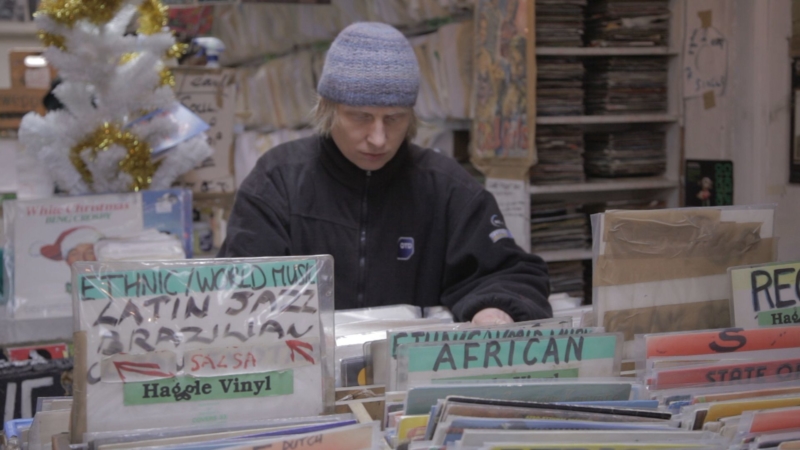
Bjørn_Torske at Haggle Records, London-2014
How did you present your first album [Feil Knapp] to Joakim (STSS)? I don’t know where to begin, but basically, Per and I were always plotting and loved what The KLF were doing with their music, art and the industry, so Per suggested we play a prank with the album and STSS. So, what happened is that I gave the album master CD to Per who cooked up this idea whilst he was touring China! He took a handheld camcorder to Oslo Central Station and he made a ‘covert’ film of the CD being put into a small luggage/post locker. Whilst filming he took the CD, walked into the station and straight up to the box [number 30?], opens it, puts in the CD, pays with coins, gets the key and then turns off the camera. Next, he goes to the Post Office and manages to put the key envelope with no stamps, no address, nothing just the key in the STSS postal mailbox. Then the next stage of the plan: Joakim was really into Pitchfork [the magazine/website] and the record reviews that STSS received, so Per designed a mimic blog called ‘Fitchpork’, posting a video he’d made on YouTube with a text linking to the forthcoming Smalltown release of the Bjørn Torske album and sent this link to Joakim from a fake email. Joakim sees the mail, goes to his PO Box to grab his mail and returns to the office. He opens the envelope and finds a key and it took a week to connect the video, the key, P.O. Box and station but he finally got the album CD from the Postbox. It was a bit of fun; I delivered my second Kokning album on a USB stick hidden inside a marzipan Codfish [Norwegian for Torske].
How do you create your music? It’s mostly inspired by DJ sets. I get a lot of material from playing records to and experimenting with music live. I will mix two tracks of totally different styles, and if it works then try and recreate the idea in the studio. I will use software such as Ableton to begin creating snippets of sequences, and then compose and transfer the idea to an instrument so that I can play it live. If it requires live drums then I will add them and once all done go into a studio to mix it down! I feel my eclectic style falls in between the main genres of the Norwegian dance scene; at first, I was into the Detroit sound, which you can hear in my earlier album, but I just want to explore music to find a combination of styles and genres. I have also produced other artists, for example, Crimea X from Italy. I spent a week in a studio in Bologna, Northern Italy re-recording instruments, composing and re-arranging the compositions, and returned to Norway with the Pro Tool Sessions to mix them in an entirely analogue studio.
Has the natural environment of Norway influenced the music scene? Initially, everyone producing and performing music was trying to escape the dull reality of living in Norway, which we saw as a totally ‘not’ happening place to live. So, we began travelling to London to buy our records which very influential to us. I think Norwegian-ness is something I became aware of later because it inspired us to make music and live here as well. I’ve never lived in any big cities, and if I had lived and produced music in Berlin or London it would definitely have influenced my music and perhaps, even take my music in a different direction. Bergen, it’s relaxed, it’s close to nature, it’s very green and I feel a strong attraction and influence from that.
What’s your favourite ever Norwegian record or piece of music? Wow! That’s quite hard to answer. A contender is Erot’s remix of Mental Overdrive’s track ‘About Jazz’. I can’t explain why, but it’s a massive dancefloor track when I DJ that I like to pull out, the Idjut Boys put it out on their Discfunction label. It’s astonishing how it works and speaking as a DJ, I think that might be the best.
Who’s your favourite Norwegian producer? Biosphere
Favourite ever Norwegian club? Café Opera in Bergen, Oslo’s Jazid in its heyday, and also Skansen runs it close.
These excerpts were recorded and transcribed with some parts of the interview being used in the final print of the Northern Disco Lights feature documentary film.
© Paper Vision Ltd (Pete Jenkinson/Ben Davis)
Recorded on a Zoom H2.
Transcribed by Fingertips, Louie Callegari and Tongue Tied.

